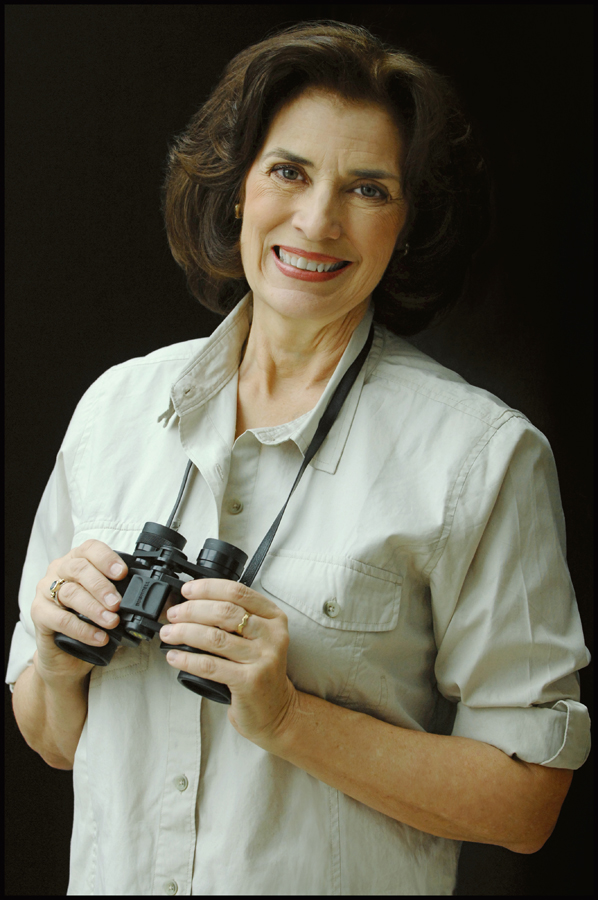by guest blog-post author Karen De Mauro
The whole bird vibrates. Side-lit by sun, a bobolink spills song across new meadow grass on old farmland in Westminster, Massachusetts in May. Notes vector out from half a head of open beak and half a buffy helmet, aquiver with sound. With wing-pumping, reverse-tuxedo verve, this bird makes “going out on a limb” look good.
I am in the field with my teacher, Barry Van Dusen, in mid-spring – out early in the day, out ready in the field where things are just beginning. It’s my first bobolink. And I’m completely happy.
What great good fortune to have found him! To continue to borrow his good eyes and fine ears, and to receive gift after gift of craft, and beauty, and sheer good will.
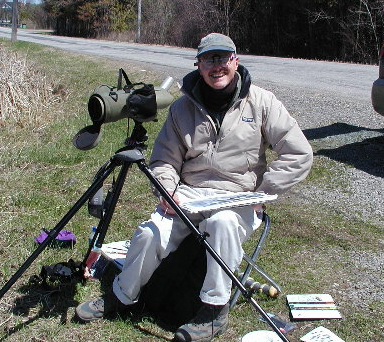
2014 Master Artist Barry Van Dusen. The 2014 Birds in Art exhibition remains on view through Nov. 16, 2014, at the Leigh Yawkey Woodson Art Museum.
Being with Barry guarantees a shift beyond observation and execution into immersion and delight. So here we are, learning together anew again.
There is no substitute for direct experience.
Moment by moment, notes arc. Light shifts the meadowland from shades of shimmering mint to mauve, to palest ochre, then to dewy transparence. Hazy heat silvers the grass; the color of the bobolink’s head becomes the color of the undersides of leaves of milkweed and mullein.
A swath of hill rolls toward us from a far-off edge of old, old trees, so old we’re really glad that they’re still here. Because the landscape is essential to the bird, Barry segues from how to mix luminous gray from ultramarine and cadmium for reflected light, into “How to do Perspective 101.”
I stand behind his right shoulder and we gaze from bird to Barry’s sketchpad to my own and back again to bird. Then we take a brief glimpse through binoculars, a much longer one through a scope, and back again to the bird. With Barry, it’s always back to the bird.
As we draw we talk: of habitats and the loss of them; of the shaky reputation of the bobolink itself through time as hated Southern rice eater; as subject of the onomatopoeic poem by William Cullen Bryant; and as Jamaican “butterbirds” for lunch at peak migration time. No longer so maligned, the bobolink, like many kindred creatures, suffers from a lack of nesting ground. It has been found to be an indicator species of just how shortsighted we can be. But I get to be farsighted, because I am with a man whose skillful mind and heart turn observation into the intimacy of absorption.
I first met Barry years ago. I lucked out while reading John Busby’s book, Drawing Birds, and saw what I now know to be Barry’s signature style of animate shape and keen expression. Busby had included a sketch of a Yellow-rumped Warbler, as an example of how Barry recreates the energy and vigor of what he sees as well as his delight in seeing itself.
It all began the day I first called Barry, and he said yes. Well, it’s key to say, he did not say yes right away, because he was in the field across the world with friends. He was, as he often is, doing good work for The Artists for Nature Foundation. Barry’s charity, collegiality, and generosity are traits matched only by his talent. But, as it turns out, it’s the character of the man that pours into the art of the man, and then gets passed on to the student lucky enough to study with the man.
Barry’s mission is this conservation for a cause, this preservation of the precious, this out-and-out devotion to what matters. And he has been doing this for decades. Whether he’s sketching to capture a moment in time, or painting a glimpse of boisterous bobolink or foraging yellow-rump, Barry is the real deal.
What Barry wants is to open people’s eyes to birds and their beauty and so to tap into a desire to protect them. He does all this but much, much more. His art moves both viewers and observers from admiration into action. And he’s really down to earth and practical. He’s local and loyal. So it’s easy to forget the visionary he’s always been when he takes the bug spray and pet travel tube of Sennelier violet out of the trunk.
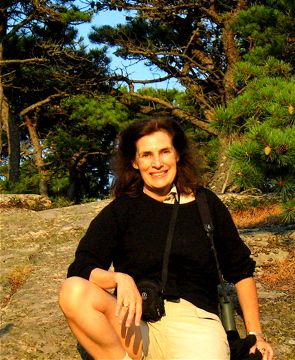 I arrive at his studio for today’s trip and notice he’s done his usual hours of prep for our trip. He’s pulled and marked old sketchbook pages to illustrate shape and line in action; he’s checked new websites and chosen a great location and a back-up one; he’s packed sandwiches, boots, and replenished his field kit; and he’s and made a digital folder of relevant “birds and blooms” photos from his residency at Tower Hill Botanic Garden.
I arrive at his studio for today’s trip and notice he’s done his usual hours of prep for our trip. He’s pulled and marked old sketchbook pages to illustrate shape and line in action; he’s checked new websites and chosen a great location and a back-up one; he’s packed sandwiches, boots, and replenished his field kit; and he’s and made a digital folder of relevant “birds and blooms” photos from his residency at Tower Hill Botanic Garden.
In addition to carrying on his usual orderly, masterful pursuit of his own work, he holds my goals in mind for weeks before I come to Princeton. And, true naturalist that he is, he readies his responses to my questions rather than superimpose his own agenda. He also has tapped into his reservoir of relationships to find those artists whose work best supports my growth. As a writer and teacher of literary naturalists, I am interested in how to interweave visual images with words so that they mutually complement one another. I also seek a daily way to get this done in the midst of my complex urban life.
From the first day I arrived at Barry’s studio – a meticulously considered, light-filled combination of sanctuary and workshop – surrounded by his wife’s exquisite gardens, I get to experience “Barry and Friends.” I come to learn Barry’s meaning of community as a web of support that simultaneously serves both the greater good and the individual.
Within minutes of our first meeting Barry pulls out a Darren Woodhead painting of shorebirds and says, “Look how he gets the sense of flight and light as only Darren can.” As a true newbie, barely a birder, and an innate competitor, I am struck by the ease with which he accepts the gifts and dilemmas of others. Barry is a true problem solver, rife with patience, empathy, and interest. Rather than focus on my bad eyes, worse ears, and frightful lack of retention, he focuses on what we share and works from there. He knows us both to be devotees of the beautiful, fans of the familiar, appreciators of the ephemeral, and admirers of the individual.
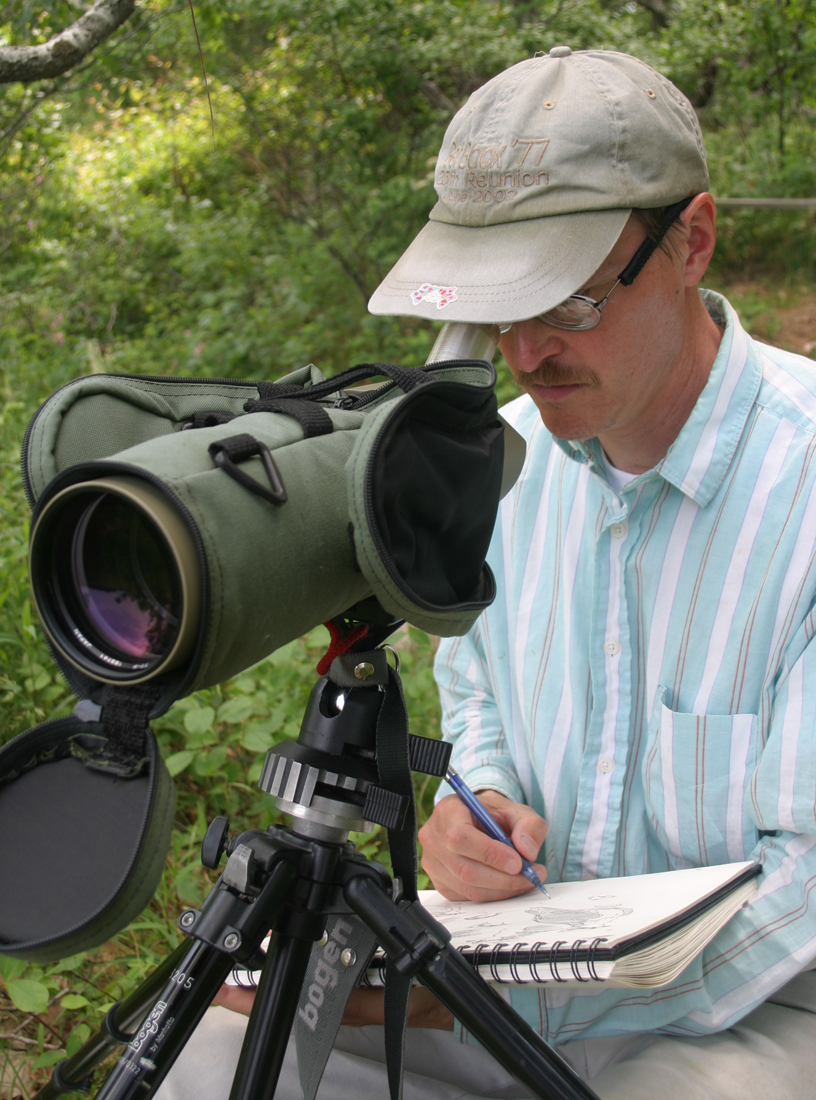 Best of all, Barry is a great guide. I know I will not get lost because he knows the way. He saves me hours of time, frustration, and costly mistakes. He’s learned the routes to take and finds the most productive trails for the season and the day. He’s fun and truly kind and knows the time things take.
Best of all, Barry is a great guide. I know I will not get lost because he knows the way. He saves me hours of time, frustration, and costly mistakes. He’s learned the routes to take and finds the most productive trails for the season and the day. He’s fun and truly kind and knows the time things take.
With infinite tenderness, Barry urges me to open up my habitually enclosed shapes, to free my hard-won heavy lines of stained glass leading around my all-too-solid primaries. He leads me into the land of soft and lost edges, a world of luminous shadows, a place and palette where reflected light and cast shadows honor the spaces between things, as well as the things themselves. He is careful, gentle, and rich with the kind of knowing that only comes from time spent in the story, life lived in the field.
And what an artist! What a blend of accuracy and spontaneity, pursuit of plumage patterns and feather tracts, selection and extraction of nuanced shape and vibrant negative space that interacts with all of this. What an active investigation of story and place, history and heritage, line and lineage he conducts. How seamlessly he moves from recording to responding, from examining to extracting, to rendering both the wholly new and the utterly familiar in the same painting.
Good artists, like the subjects they paint, have a recognizable set of signs, a personal iconography that becomes a signature in the way they express shape, line, and color. Barry is the king of shape – of a sense of shape that goes far deeper than form. This is, as Busby says in Looking at Birds: An Antidote to Field Guides, “the outward forming of an inner gesture, an energy that extends beyond the container”.
Another key element of Barry’s process involves this understanding of the time things take. He can wait for paint to dry, or a fledgling to fly, because he trusts there is no better way to do this. He knows that direct experience takes time. Time spent observing is time well spent. The act of observation connects us to people, creatures, places, and things. We become invested where and when we spend time. And it takes time to meet the many challenges of being in the field, from bugs to weather, from ticks to timing, from glare to shadow, from fleeting glance to sure identification. It is not just a way of seeing; it is a way of being.
It is in this way of being that the richest learning with Barry begins. What I learn along with local color and contours, habits and flight patterns, goes on beyond birds. I learn work habits and patience, stage-appropriate behavior and attention to detail, necessary sacrifice, and work/life balance. I learn to concentrate. When I get weary, Barry carries me on his seemingly inexhaustible concentration, until I learn to do this for myself. It is a concentration built on dedication, on location, in places as varied as the public marketplace to his secret heron rookery. His is the concentration of the lifelong learner and true enthusiast.
The root of the word enthusiasm means “to be filled with the breath of spirit,” another good way to describe Barry. He is a gifted and enthusiastic transmitter of tools and techniques, of faith and forbearance, a persistent presence. I’ve always wanted, as Rilke urges, “to be with those who know secret things . . .” Through Barry, I get to partake in a long line of kindred spirits from Ennion to Busby, and then from Busby to Barry. Their breath flows through their brushes, their words, and on out into me in gesture, sound and line.
From Barry, I learn how observation can move us from a finite love affair with the natural world into a committed relationship that lasts. Because I, too, am in this for the long haul. I learn to attune to a creature’s point of view, to a place’s hidden contribution, and to a community’s response-ability to all of this. I learn because I am with an artist whose art and life are rich with kindness and care. Perhaps his talent is surpassed only by his generosity.
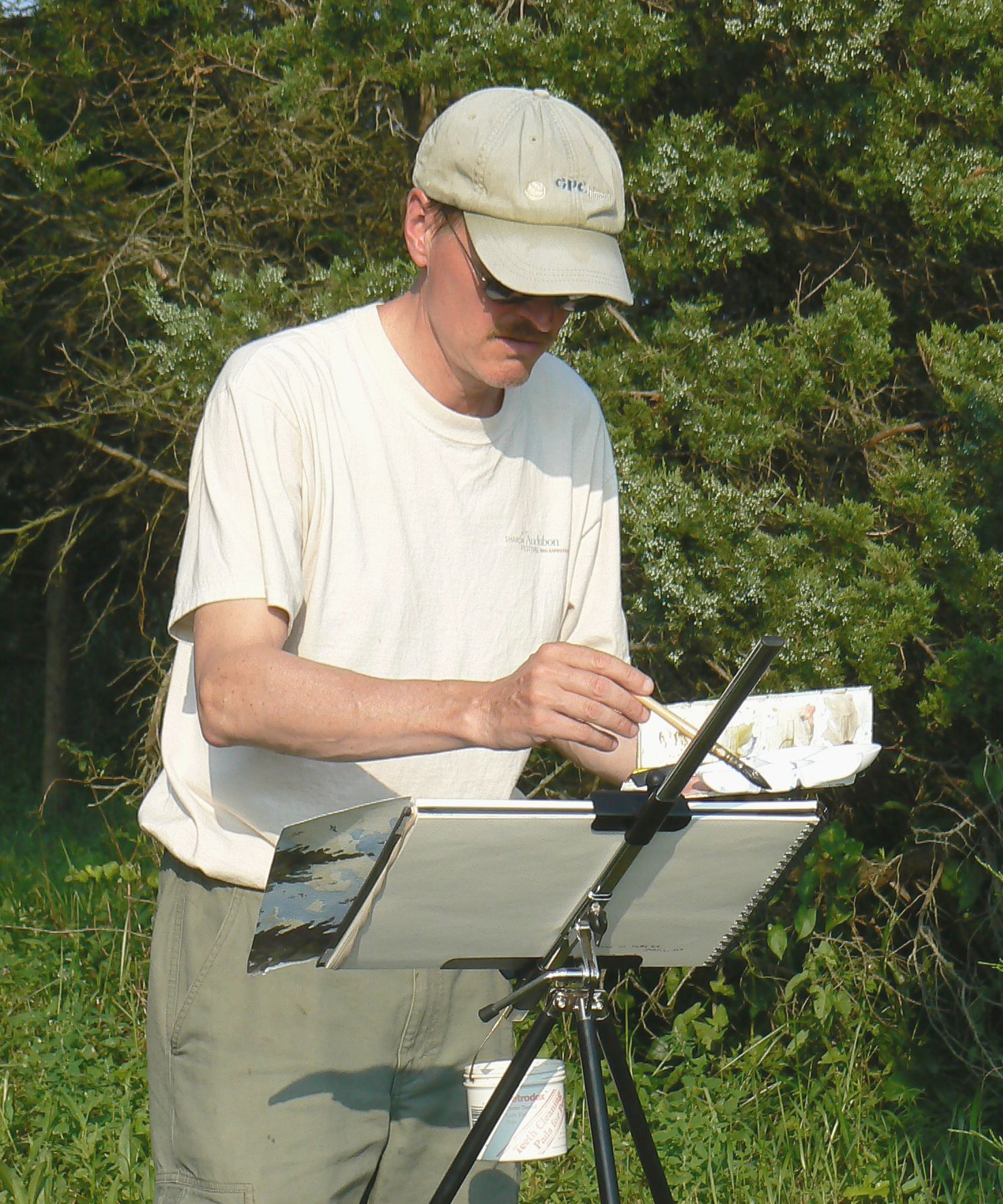 Much of Barry’s generosity extends to his fellow artists, a character trait that pours benefits onto me. I learn through Barry of Debbie Kaspari’s line in motion, of Michael DiGiorgio’s uncanny skill with dark nights and inaccessible places. From the get-go, I get best practices and good watercolor paper. I get a Busby conduit, flavored with his awe and admiration. Barry teaches me that there is no substitute for the real bird in the real field in a real moment in time. So, along with a palette of more greens and complementary mixed greys than I even knew existed, I get to walk around with him to share spring ephemerals, wonders, and Myrtle warblers. This brings me to how I bought my first-ever painting.
Much of Barry’s generosity extends to his fellow artists, a character trait that pours benefits onto me. I learn through Barry of Debbie Kaspari’s line in motion, of Michael DiGiorgio’s uncanny skill with dark nights and inaccessible places. From the get-go, I get best practices and good watercolor paper. I get a Busby conduit, flavored with his awe and admiration. Barry teaches me that there is no substitute for the real bird in the real field in a real moment in time. So, along with a palette of more greens and complementary mixed greys than I even knew existed, I get to walk around with him to share spring ephemerals, wonders, and Myrtle warblers. This brings me to how I bought my first-ever painting.
For over three years I saved to buy “Butterbutt,” Barry’s radiant watercolor of a Yellow-rumped Warbler that catches its habits and habitat in a moment in time. I saved and sent increments of fives and tens. Barry kept track of them in his impeccable script. I’m not a saver and only a sometime investor, but I am a true fan of the beautiful hidden in the familiar. Every day I look at this painting, and every day it gives me pleasure. It captures a unique moment in time that flows out of a lifetime of dedication.
So why devote a lifetime to bird art? Because birds are indicator species, and their beautiful, ephemeral, fierce fragility points to a bigger picture than the one that hangs on my wall. They are avian portals to the local and the global. Their migrations, as Scott Weidensaul says, “stitch the continents together,” and the art of them stitches people together into active communities fueled by love, hard work, and abiding appreciation.
So is the long journey worth it? Absolutely. To walk with Barry is to take a walk that’s unlike any other walk. A walk with such a vision of the bird! It is a walk that turns into a dance of color and light and shape within, around and through things. Barry’s right. The experience of encounter is irreplaceable. And you really get it only in the presence of the actual bird, the original artwork, and the real man. I am the fortunate recipient of this vision: tenderly filtered, meticulously sifted, and wonderfully made by Barry Van Dusen and friends.
Visit this website for more information about guest blog-post author Karen De Mauro.
Connect with Karen at naturekaren@yahoo.com
Write a blog-post-related comment on the Museum’s Facebook page.

